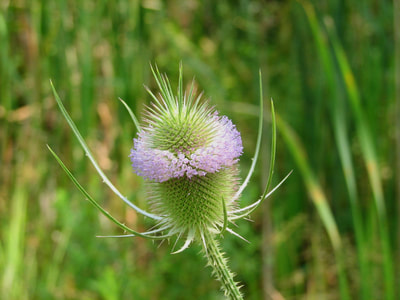|
Poetry of Teasel Johnny prick the finger, brush and comb, Many are the folk names teasel owns. Venus lip and Venus basin, For she traps insects for her nutrition. Sacred water she collects in cups, Refresh one’s eyes with a healing touch. She teases out the fibres of finest wool, Pink and white flowers decorate this useful tool. J.Huet 2017 Teasel Dipsacus fullonum Teasel is a marvel that even Lewis Carroll would struggle to create in his exceptional stories. A green spiky armoured plant that traps insects in small cups and grows a brush for its head. The brush is decorated with tiny pink and white flowers made of four delicate petals borne on long tubes. Pretty golden birds feast upon its seeds called goldfinches and the plant provides sacred water and soothing roots. It seems wonderland is right under all our noses! This distinctive tall plant grows in waste areas, on the edges of fields and woods and on the banks of streams. It is a biennial growing from 4 to 6ft high. A dense prickly flower head appears on top of this upright plant dwarfing the largest of thistles. It is known as the brush and comb plant for it is as if nature decided to create a natural brush. Eventually a cultivated variety with additional hooks known as the fuller’s teasel (D.sativus) was created. The fuller’s teasel however is not an ordinary brush but a specialist tool used for raising the ‘nap’ of woollen cloth in the manufacture of velour and cashmere. This variety of teasel is especially grown in Somerset. Teasel is a contender for our own native venus fly trap. The Romans were well aware of this calling it names such as venus lip and venus basin. These names refer to cup-like structures which are formed around the stem by the leaf bases. In these cups insects are trapped and it may be possible that the plant makes use of the nutrients released from the dying insects. For the herbalist this is sacred water for easing inflammations of the eye and as a cosmetic to ‘render the face fair’ ( Culpeper 1616-1664). The fresh plant in flower made into a tincture can be used to ease inflammations of the skin and its roots as an ointment to cure warts. The doctrine of signatures written by Paracelsus (1493-1541) and probably employed by much older indigenous believe systems states that God created disease and the plants with which to cure it. Each plant has a signature that indicates its use if we look closely enough, such as Prunella vulgaris which has a flower shaped like a scythe and is therefore used for cuts. I don’t recommend you look too closely at this huge inflamed plant that cures warts and soothes inflammations. Teasel is yet another example of the fascinating and extraordinary weeds that surround us. If you wish to learn more please subscribe to our monthly newsletter or join us on a course where we can soak up the beauty and learn a deeper appreciation.
1 Comment
7/8/2019 03:16:45 am
I know very basic information about flowers that's why I came here on your website. Featuring Teasel was a good idea because I am sure that not all people are familiar with its name, they just know how it looks like! It's a tiny flower yet if you are going to look at the details of the flower, it's overflowing! There's so much happening on the flower and I couldn't get over! By the way, the short poem that you wrote was perfect for me!
Reply
Leave a Reply. |
Details
Poetry of flowersJoin me to explore the flora of the British Isles on this blog. My intention is to attempt to capture the unique quality and beauty of each species of flower, tree or shrub. For every species featured I will be growing many more wildflowers to celebrate the joy of their existence, their intrinsic conservation value and bewildering array of uses. For nearly 30 years I have noted, studied and explored wildflowers in the field much to the patience of the walker beside me. To share this passion is a heartfelt plea to respect, preserve and care for all British Wildflowers no matter how common they seem. Archives
February 2024
Categories |


 RSS Feed
RSS Feed
